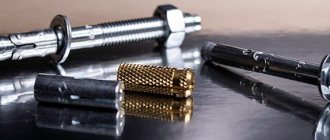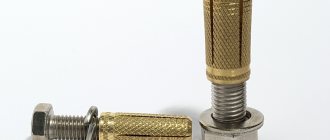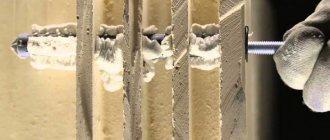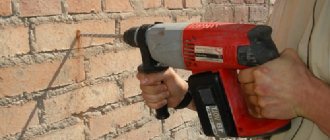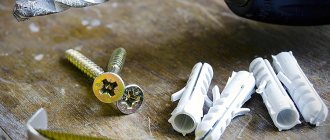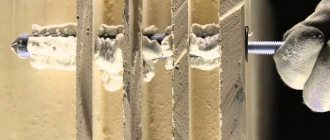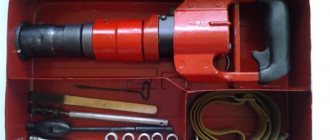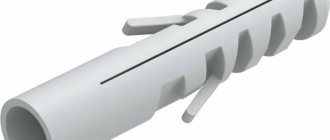An anchor bolt for bricks with voids is a mandatory attribute of almost any building under construction. Hardware can be of chemical or mechanical type. The former are not as popular, but are more effective than classic devices. Let's take a closer look at each of them.
Installing anchors in a hollow brick wall Source stroy-podskazka.ru
Types of anchors
Anchor fasteners for hollow bricks differ not only in their dimensions, but also in their technical and design characteristics. Based on this, the areas of application of the anchor are distinguished, which are aimed at solving certain installation problems. In this regard, anchor bolts are divided into several types.
Driven type
This is the simplest type of anchor fastening systems. They are used mainly for fastening on structures built from solid brick. Its operating principle is that an anchor is installed in a pre-prepared hole in the wall, after which a special spacer element is activated in it, which ensures reliable fixation of all fasteners. At the end of installation of the main part, a threaded element is screwed into the bolt.
Wedge type
This design of the anchor bolt has a special element that is wedged during installation. It is precisely because of this feature that this fastener got its name. The wedge element, entering the brickwork, expands and reliably fixes the fastening system to the building structure.
Products according to MSA type
Their main feature is the presence of a brass sleeve in their design. On its side there are longitudinal cuts, thanks to which the sleeve is divided into peculiar petals, which expand during installation. And in order for the expansion of the spacer sleeve to be as large as possible, the internal hole in it has a cone-shaped shape.
Chemical type
An anchor bolt in a brick wall, working on a chemical principle, is fixed in a previously prepared hole using a special glue. This type is most suitable for use on walls constructed from hollow bricks and other porous building materials. This is due to the fact that the adhesive composition, which is used with this type of anchor fasteners, fills all internal cavities, thereby reliably fixing the bolt.
Anchor with ring
In this case, the ring replaces the standard hexagonal bolt head and is designed for more convenient and easy installation of various objects.
Double spacer anchor products
Their peculiarity lies in the presence of a spacer sleeve in the design, which expands during installation in several places simultaneously. Therefore, it is widely used when installing various products on structures made of hollow bricks, since at least one of the spacer elements falls on the solid part, while the rest are in the empty part.
What are anchor bolts for masonry
A brick anchor is a universal fastener that is equally successfully used both in the field of capital construction and when performing simple repair and improvement work on buildings and premises for various purposes. With the help of such fasteners, which are a bolt of a special design, objects and elements of even significant weight can be securely fixed on the surface of a brick wall. Such anchor bolts, in particular, can be used to secure furniture and interior items, lamps and chandeliers, suspended ceilings, wall-mounted facades and much more.
The design features of this type of bolt and the principle by which it operates are contained in its name: anchor in German means “anchor”. The element that ensures reliable adhesion of such fasteners to the inner walls of a pre-drilled hole in the brick is a special sleeve. Placed in a hole in the wall, when the head of the anchor bolt is twisted, it begins to increase in diameter, pushing out the inner walls of the hole and coming into reliable engagement with them.
In order to make the adhesion of the anchor bolt sleeve to the walls of the hole in the brick even more reliable, a special notch is applied to the side parts of its outer surface.
Rules for installing anchor systems
Make a hole for the anchor using a hammer drill in drilling mode
With the advent of household hammer drills, the installation of fastening systems in the walls of buildings has become significantly simplified. The older generation remembers the pain it took to install anchors.
Using a special metal tube (bolt), under the blows of a hammer, a hole was slowly made in the brickwork. Now such an operation takes minutes.
To correctly and safely install anchors in a brick wall, you must adhere to the following rules:
- Whenever possible, the hammer drill is used in drilling mode. Brick is a rather fragile material and can simply crack and collapse under impact load. The resulting hole will not fulfill its purpose.
- The temptation is to make the work easier for themselves, they drill holes in the cement joints of the masonry. However, this position of the anchors can lead to dire consequences. Under heavy loads, the cement crumbles and hanging objects can simply fall to the floor.
- When drilling, you need to strictly control the horizontal position of the drill. At the slightest downward inclination of the cavity, there is a risk of the anchor falling out under the influence of an increased pull-out load.
- When driving the supports with a hammer, place a spacer (wooden plank) under the anchor. This allows you to protect the stud threads from damage.
- Before installing the anchor system, you need to check the cleanliness of the surfaces of the sleeve and rod. For more information about working with an anchor bolt, watch this video:
By following these fairly simple rules, you will always be confident in the strength and reliability of the fastening of hanging furniture and other items.
How to drill a hole in a brick wall
How to attach a sink to a wall
Installation of timber walls
Anchor in a brick wall
In modern construction, hollow ceramic stone is often used to construct load-bearing walls and partitions. When arranging a room, home owners are faced with the question: how can they securely fasten heavy objects to the walls (wall cabinets, air conditioning, etc.)? Today's article will help solve this problem.
Some types of brick, due to their unusual structure and large number of cavities, are considered fragile by many craftsmen, but this is not the case. Hollow brick has the same strength as other types. You can make holes in it without fear
But, for greater fixation of fasteners, it is still better to pay attention to new and modern technologies
Conventional fastenings are already fading into the background. Chemical anchors, which are an alternative to all old methods and fastenings, are gaining increasing popularity. It can withstand very heavy loads. And its fixation takes the same amount of time as conventional fastenings require. The anchor is specially designed for reliable fastenings in different types of ceramic stone, including hollow ones. In the case of such bricks, modern fasteners are used in conjunction with nipples, which have special holes that ensure strong fixation of the fasteners.
Types of anchors for working with brickwork
Today there are many types of these fasteners. They have different purposes, therefore the design of different anchors is different. For example, there are so-called frame anchors, which are used only for attaching windows and door frames to the wall. There are foundation anchors. With their help, metal columns are installed, for example.
Anchors of different sizes are also designed to perform different tasks.
Chemical anchor for hollow bricks and ordinary bricks.
The future strength of the structure we create will depend on the correct choice of the fastening system.
Let's look at anchor systems used for brickwork.
The driven anchor consists of a spacer (sleeve), a bolt and a nut. The spacer part is hammered into the prepared hole. The bolt is screwed into the spacer together with the nut, then the nut is removed. This type of mounting fastener is used for subsequent screwing of hinges or corners using a nut. You can hang shelves, cornices, etc. on them.
There are such types of drive-in anchors as hook bolt, angle bolt, and ring bolt. Their purpose is different from that of conventional bolted anchor fasteners. For example, heavy kitchen cabinets or bathroom water heaters are usually hung on a bolt angle. The ring can be used to hang, for example, wickets or gates in a brick fence.
Scheme for screwing a dowel into a brick wall.
Wedge fasteners are used more often for through fastenings. The wedge firmly holds the attached element on the wall surface.
The so-called MSA. This fastener is made of brass. Like all fastening anchor systems, it has a notch on the outer surface of the sleeve for better adhesion to the inner surface of the hole in the wall material. The maximum internal section of the sleeve is 8 mm. It is intended for fastening not very heavy products and materials to a brick wall.
The double expansion anchor consists of a pin with two expansions and a sleeve with cuts in the middle and at the end. Thanks to two spacers, the fastening is more durable. It is used when installing on a wall made of hollow bricks, when greater resistance to tearing is required.
They also make double-spacer fasteners with a nut and a pressed washer. This type is used for fastening metal. Such systems are made of galvanized steel.
Not so long ago, a new type of anchoring system appeared - adhesive, or chemical. After all, attaching something to a wall made of hollow bricks is very problematic. For this purpose, this type of fastener is used. Instead of a sleeve, it uses an ampoule with a special polyester glue into which a pin is screwed. After a short time, the glue hardens, and a reliable fastening is ready.
Chemical anchor, fastening with glue
Fastenings based on filling the inside of a metal rod embedded in the wall are used to provide strong connections in stone, brick, sandstone, shell rock, limestone, and cellular concrete. Such connections involve the use of chemical anchors, for example the popular all-season type moment fastener CF900. A metal insert, which is a reinforcement rod, a threaded stud or a sleeve with a thread on the inner surface, goes deep into a prepared hole, the diameter of which exceeds the anchor parameter by 2 mm. After this, a capsule with glue based on polyester, polyurethane or acrylic resinous substances, a hardener and filler in the form of sand is inserted into the sleeve. Then the glass cylinder is destroyed and a metal rod is inserted into it and the binder is waited for setting.
Features of application
The installation process is carried out in several stages. The main ones:
- Preparing the hole.
- Train room.
- Installation of the anchor in the uncured polymer mass.
- Tightening the nut.
Each of these stages is associated with its own characteristics.
For installation you will need:
- chemical anchor;
- injection gun;
- stud or threaded fittings;
- hammer drill or drill;
- Boer;
- torque wrench;
- metal brush;
- manual or industrial vacuum cleaner;
- Remedies.
Once you have the tools, you can begin installing the chemical anchor.
Preparing the hole
When working with brickwork, it is important to avoid splits and cracks in the brick. This requires refraining from using the hammer function on the equipment and drilling perpendicular to the plane
To successfully install a chemical anchor for hollow bricks, a hole that is 2 millimeters larger than the diameter of the stud is required. It is necessary to apply a mark on the drill in advance corresponding to the length of the anchor, or use a depth limiter.
To improve adhesion, you need to thoroughly clean the hole from dust and crumbs. This is done using a metal brush and a hand pump, with which the hole is blown several times until there are no visible dust residues.
Introducing the composition
The polymer mass is injected into the hole using an injection gun. If the mixture has a uniform gray color, then it can be used. It often happens that initially it is not possible to achieve high-quality mixing - such a mixture should not be used. To use the gun, you need to place the nozzle in the drilled cavity and fill it with the composition. After each dose of glue placed in the hole, you need to remove the tool a little until more than 65% of the cavity volume is filled.
The procedure for placing a chemical dowel into a hollow brick is characterized by a number of features. They are due to the fact that the presence of a large number of voids does not allow the formation of a natural hole. To achieve the goal, a special plastic sleeve is inserted and filled with glue. When a pin is immersed in a hollow brick, part of the chemical composition escapes through the mesh walls of the sleeve into the cavity. This promotes greater grip.
There are also special ampoules. They are placed in the hole, the composition is mixed using a pin. The second option is more suitable for piece work, when there is no need to buy cartridges with a chemical composition.
Installing a metal anchor
We place the metal structure in the hole using rotational movements
It is important to distribute the solution evenly. To do this, it is recommended to periodically pull the fastener towards you and only then tighten it.
While the glue dries, you can correct the position of the anchor.
Tighten the nut
After waiting for the polymer mass to completely harden, you can proceed to installing equipment and structures. The manufacturer's instructions indicate the maximum force applied to tighten the nut. It is recommended to use a torque wrench to control the applied forces.
Chemical anchors are suitable for fasteners made of steel. Due to its positive properties, the anchor can be installed in high humidity or even under water. When used correctly, it is possible to avoid destruction of the brick, which allows installation at the very edge of the surface.
Chemical anchor is a new direction in construction, thanks to which complex work is simplified. The supply market is becoming more extensive, a larger number of anchors with various new fastener characteristics are appearing.
Features of lightweight brick walls
Walls are hollow for two reasons:
- First
: when slotted brick is used for masonry. - Second
: when the walls of a building are lightened by constructing cavities-wells inside the masonry, which are then filled with heat-insulating material. When making well masonry, both hollow and solid bricks can be used, so a variety of anchors may be needed in the work.
Well cavities in brick walls
Well-type masonry consists of two parallel walls connected to each other by transverse diaphragms - which is what we see in the photo above. It is they who perform the role of anchors in this case. Thanks to them, vertical wells are formed, which, in order to increase the thermal properties of the enclosing structure, are filled with either foam insulation or loose insulation.
As an option, concrete-anchor masonry can be performed. What is she?
In principle, this is a type of well masonry, only here cellular or ash concrete is used as insulation. Since it hardens and forms a strong monolith, the means to achieve maximum structural rigidity here is anchor brick.
Anchoring lightweight masonry with bricks
This intriguing name hides the most ordinary bricks, which are laid into a row of spoons with pokes. This is done so that the protruding edges form teeth in the internal cavity of the wall.
During the hardening process of the concrete poured into the wells, the anchor bricks will be firmly fixed in it. In the above picture, even without words, you can clearly see how in this case the anchoring of the brickwork is carried out.
Types of masonry
Types of facing brick masonry
Based on the location of the bricks in a row, several types of masonry are distinguished:
- front (bed) - the brick is laid so that the widest side is visible;
- spoon - the long narrow side is visible from the outside;
- bonded - only the ends of the bricks are visible from the outside.
Types of masonry
In addition, masonry is divided into types according to decorativeness:
- “half-brick” masonry - the vertical seams of the spoon or bed masonry are shifted horizontally by half the length of the brick;
- stacked - vertical seams between bricks are located on the same line;
- Flemish - spoon and bonded masonry alternate in one row;
- “American” - spoon and butt masonry alternate in rows.
Decorative facing brick
If you have no experience, it is better to start with standard half-brick spoon masonry, and as your skill improves, you can try other methods. It should be noted that stacked masonry is the most unstable, therefore it is used exclusively for decorative purposes.
How to properly install an anchor in brickwork
Anchor products used for fastening various objects on brick structures are designed in such a way that their installation does not cause any difficulties. It is performed in the following sequence.
- A hole is drilled in the structure to be fastened. Its diameter must correspond to the diameter of the anchor product.
- After thoroughly cleaning the hole, an anchor bolt is driven, inserted or screwed into the brick.
- When tightening the bolt head, it is necessary to achieve maximum expansion of the spacer sleeve, which will be evidenced by reliable fixation of the fastener in the brickwork.
Anchor installation principle
When choosing a place to drill a hole, you should pay attention to the fact that it does not fall on the gap between the bricks filled with cement mortar. This hole should only be made in the body of the brick itself.
It is also necessary to pay attention to the condition of the material from which the building structure is made, because cracks in it can significantly weaken the formed connection
How is the installation carried out?
To install fasteners for hollow bricks, it is recommended to adhere to the following rules:
- The diameter of the prepared hole must be equal to the diameter of the fastening system.
- Before installing the sleeve into the wall, you need to clear the hole in the brick from dust and debris.
- Tightening the inner bolt should ensure that the inside of the anchor is fully expanded. This guarantees the reliability of the fastener.
- The anchor system is inserted only into the body of the brick, and not into the layer of cement mortar.
- The brick wall must be strong and without damage. Cracks weaken connections.
Anchor systems are used as part of external and internal work. For fixation, you need a preliminary calculation of the number of ties, the shear strength of the masonry and the level of resistance, the peculiarities of the fastening principle relative to the type of brick, etc. Sometimes it becomes necessary to use additional devices, for example, a corner for an anchor system.
Anchors for hollow foundations
The instructions given in the previous chapter were focused on anchoring the walls themselves during their construction and brick cladding. Now we will look at which brickwork anchor can be used when you need to hang a cabinet, lamp, CCTV camera, etc. on the wall.
Types of fasteners
There are no problems with solid brick walls: they simply drill holes in them and install dowel-nails. But for walls built from slotted bricks or porous ceramic blocks, this technology is not suitable. Due to the hollow structure of the base, a regular dowel will not hold - for this you need anchors for hollow bricks.
And this is what manufacturers offer to our attention today:
Product typeUseful information
Wedge type anchor, with nut
This anchor bolt is used for bricks - and not only solid ones, but also hollow ones. And in general, it is suitable for almost any base, except for plasterboard sheathing. The wedge anchor has the highest degree of reliability, and therefore is used in cases where something very heavy needs to be hung on the wall. It is also suitable for through fastenings.
This is a steel rod with a diameter of 6 to 24 mm, of various lengths, with a movable coupling and a cone-shaped shank. When the nut is tightened, the cone opens and the anchor is firmly fixed at the base.
They are made of galvanized steel, the price starts from 3.5 rubles. a piece.
Drive-in anchor, with expansion sleeve
This type of anchor is perfect for all types of hollow foundations. It consists of a spacer, usually a brass cylinder sleeve, a fastening element (bolt), and a fixing nut. First, they are screwed together, and then the nut is removed. Moreover, the bolt in such an anchor can have any shape: a hook, a ring, an angle, which allows you to use such anchors in a variety of situations - for example, hanging a water heater on the wall.
The cost depends on the size and material of manufacture, and varies from 4 to 50 rubles. a piece.
Two-component chemical anchor
These anchors provide the best grip on the wall and can be used in a wide variety of situations. Among them there are also options for both monolithic and hollow bases. The chemical anchor is held in the brickwork by a nylon sleeve, which increases in volume after the introduction of a special two-component composition. A long threaded rod is installed into it, and when the filling polymerizes, an almost monolithic connection is obtained.
The cost of a tube of adhesive composition, with a hardener in a separate package, is about 1,350 rubles. Studs with nuts cost about 45 rubles and are purchased separately.
What anchors for foundations with reduced load-bearing capacity have in common is the presence of sleeves with which they adhere to the wall. The point is that when installing the sleeve into a drilled hole, it expands and is firmly fixed, and then the anchor itself is inserted into it.
It can be anything - a pin, a screw, a long screw, or a smooth rod. But in everyday life, all these options are simply called: anchor bolts for bricks.
Fastening the facing masonry to the wall
From all that has been said above, it is quite clear that when constructing lightweight masonry, the anchor for a brick wall is the brick itself. So, when it comes to ordinary masonry, no fastening elements are needed. But to fix decorative (facial) masonry to it, completely different technologies are used.
Flexible connections
In general, when performing cladding, an anchor for brickwork can be any available metal material. Many masons believe that all means are good for this.
To anchor the facing masonry, which is carried out simultaneously with the construction of the main wall, they use pieces of steel rods and strips of plaster mesh, and even manage to make improvised anchors with their own hands from scraps of aluminum profiles.
Anchoring with steel rods
Note! There are many types of anchors specially designed for fastening brick cladding, which are called flexible ties. Why flexible? Yes, because part of the anchor rod is made of flexible polymer or composite material. This makes sense: thanks to the movable connection with the load-bearing wall, when the foundation shrinks, cracks do not form on the facing masonry.
Composite rods and dowels
The most common are anchor rods and facade dowels with a flexible connection, made of basalt plastic or fiberglass. The rods are used for monolithic cladding - in cases where it is not possible to connect to a load-bearing wall.
For example, when the pattern of the facing masonry is formed only by rows of spoons. The rod anchors, which are shown in the picture below, can also be used when constructing a decorative wall with a ventilation gap, but without insulation.
Brick anchor: fiberglass rods for monolithic cladding
Anchors in the form of a facade dowel with a flexible connection, which you see in the photo below, are equipped with a spacer washer. They allow you not only to connect two walls together, but also to simultaneously fix the heat-insulating boards. Therefore, they are used to connect three-layer insulated walls, while simultaneously serving as disc-shaped dowels for insulation.
Basalt plastic anchor rods
This concludes all the differences between rods and dowels. All of them can withstand prolonged exposure to high temperatures and are extremely durable. By the way, in this indicator, basalt plastic is even ahead of steel.
It is also important that it has a low thermal conductivity coefficient, and reduces to zero the possibility of the formation of cold bridges. This is precisely the main disadvantage of metal rods, since they accumulate condensation and succumb to corrosion, which leads to breaking of bonds.
Perhaps someone will think that since the rod is flexible, it can be easily pulled out of the wall. However, this is not at all true. The force that needs to be applied for this corresponds to 408 kgf (4000 Newton). Such an impact only occurs during an earthquake, but when the walls themselves collapse, it is unlikely that anyone will worry about the cladding.
How to install an anchor in brickwork
- The diameter of the anchor sleeve intended for brick walls is usually 6 mm. The length varies significantly, which, in fact, determines the price of the product: from 6 to 14 rubles. a piece.
- The length of the dowel is selected so that it fits into the facing brickwork by at least 9 cm (three-quarters of the width of the brick).
- Its anchor part is always 6 cm. Clamps for insulation are sold separately and purchased as needed.
- There are also options for flexible connections for attaching brick cladding to other types of foundations: monolithic, cellular concrete. The exact number of connections is determined by calculation, and depends on the presence or absence of insulation in the wall pie.
- Its type also matters. For example, mineral wool needs to be fixed more often than polystyrene foam. But on average, the consumption of composite anchors is 4 pieces per 1 m2. Additionally, they are installed at corners, around openings, in places where expansion joints are located, and the fastening spacing is no more than 300 mm.
Fixing brick cladding to a concrete wall
What else are flexible anchors good for when building a brick wall with brick cladding? Because they allow you to connect two walls even when the horizontal joints of the masonry do not match.
A flexible connection can also be placed in a vertical seam, which cannot be done in any other case. To prevent the fastenings from loosening, before attaching the brick anchors, install the thermal insulation with glue, and then, stitching it through, install flexible connections.
Dowel for aerated concrete - design features
The soft and friable materials from which walls are built have always been problematic when it comes to attaching various household products to them. As a result, not a single manufacturer of fastening structures gave a guarantee that their anchor or self-tapping screw would adhere well to such a surface. In practice, this was very often confirmed; the soft base simply crumbled, and the fasteners lost their holding properties.
But a solution was found, it was the dowel for aerated concrete that solved the problems of installation in soft materials. The immediate solution to this issue was the specific design of such fasteners. Externally, this is a sleeve on which there are ribs made in the form of a spiral; when installing a self-tapping screw, it expands the sleeve, which, with spiral-shaped ribs, seems to cut into the soft surface of aerated concrete. As a result, we get a strong mount that holds a certain load.
Fasteners of this category are available in two versions, plastic and metal. As for the metal version, its design can also be of two types. The first design sample has the same wide spirals on its base as the plastic one, and the method of its fastening is completely identical to its plastic counterpart.
The second type of such dowel has a completely different design. It is made in the form of a bushing, which has teeth along its entire length, and the main feature is its cone-shaped shape, increasing from the bottom edge to the base. On the working surface with teeth, the metal has technical slots, which expand when the bolt or screw is tightened, and the teeth also bite tightly into the soft material.
Installation features
In the practice of modern construction, anchors are in demand. They provide a reliable way to install equipment and fix massive objects and structures on the walls and ceilings of a building
It is important to choose the right hardware for the job
Fastenings for solid bricks will not provide the necessary adhesion to hollow material
Therefore, it is important to first determine the base raw materials from which the enclosing structure was erected
Sequence of work:
- The plane is marked. The work is done with the utmost care. Hollow ceramic bricks are fragile. If you make two holes with a small interval between them, the material will most likely be deformed.
- The hole in the brick is made with a specialized drill. The cross-section of the anchor element and the depth of its placement are taken into account. The perpendicularity of the hole produced is a guarantee of high-quality work.
- After creating the hole, it is cleaned of dust and debris. Depth accuracy is checked.
- When inserting the anchor, make sure that the gap between it and the wall is minimal. If it turns out that the product is loose, it is better to take larger hardware. It should be selected according to the diameter of the resulting hole.
How is cladding done with aerated concrete?
Attaching facing bricks to load-bearing walls is one of the most important points, but before you get started, you need to understand the technology as a whole. An important point is the width of the foundation; if brick finishing is planned, it must be wide enough for this work. Usually there are no problems.
Attaching the facing brick to the wall can occur at different distances, it all depends on whether the installation of thermal insulation is planned or not. If there is insulation, then a gap of at least 3 and no more than 5 cm should be left between the aerated concrete blocks and the brick. The insulation should be moisture-resistant, for example, polystyrene foam or similar materials are suitable. Ventilation holes will need to be left in the walls. For finishing, either M-150 ceramic brick or finishing brick is used, the layer is laid in one brick, the installation method is similar to laying walls.
The facing brick can be attached to the insulation closely. If insulation is not planned, then the brick should not be pressed against aerated concrete, otherwise both materials will quickly collapse, since they have different indicators, and there should be an air gap between them.
Miscellaneous autonomous equipment
"Fisher" has many significant advantages that are worth paying attention to. Firstly, it is well suited for working with almost any building material
Firstly, it is well suited for working with almost any building material
Secondly, the fastening system itself is quite simple and universal for any construction project.
Thirdly, thanks to non-expansion anchoring, it is possible to reduce the size of edge and axial distances.
Fourthly, such fasteners are quite different and are used for all kinds of devices.
What load can a Fisher anchor withstand? There are some requirements. As for the brickwork, there is no need to worry, since such fasteners provide for any loads that may be placed on a structure made of hollow bricks.
The same applies to aerated concrete structures. If we talk about working with compressed concrete, then it all depends on what kind of threaded rods you use.
Since the Fisher fastener is a chemical device, it is distributed into two separate chambers. The first chamber contains the chemical solution itself.
The other contains the hardener. Before use, they need to be mixed and then squeezed out.
Brick anchor
Each main type of fastener has many small subspecies. However, this should not confuse you. The fact is that in any case, the principle of their application is very similar, and the differences are only small.
You can learn about the features of each subtype of fasteners you are interested in from the consultants of the store where you will purchase them.
When choosing the type of fastener to use in your home, first of all you need to decide exactly what you want to attach to the wall. Analyze what types of fasteners may be suitable for use with your materials, and then choose the most convenient one. an acceptable and economically accessible fastening option for you.
Noticed a mistake? Select it and press Ctrl+Enter. to let us know.
Installation Tips
In the modern construction industry, a large number of types of anchors are used for hollow and porous materials. With rational selection, each of them will last for decades. You just need to follow some simple installation rules, namely:
- For structures made of hollow bricks, it is strictly not recommended to use a hammer drill. Such an “aggressive” tool can easily damage the wall.
- Do not install anchors in masonry joints. These places are much “weaker” than the brick, so a fastener installed in such a weak place may lose its holding capabilities over time.
- The hole in a vertical wall must be strictly horizontal. Even a slight vertical deviation up or down will reduce the reliability of the fastening.
- When installing drive-in anchors, do not hit the metal directly with a hammer: this can damage the fastening. It is better to place a wooden block.
- Before screwing in the bolt, you need to clean the sleeve hole to avoid damaging the threads.
Compliance with installation technology will ensure reliability and long service life of the fastening.
//www.youtube.com/watch?v=0DZhJQSHCZ8
Bricklaying Tools
| Brick parameters | Hyperpressed brick | Clinker brick | Sand-lime brick | Ceramic brick |
| Compressive strength, kg/cm² | 150-300 | 300-500 | 75-200 | 100-175 |
| Frost resistance, cycle | 75-150 | 50-100 | 35-50 | 15-50 |
| Moisture absorption,% | 6-8 | Less than 6 | 6-12 | 6-8 |
| Thermal conductivity, W/m° C | 0,7-0,8 | 0,7 | 0,3-0,7 | 0,3-0,5 |
| Weight for size 250x120x65., kg. | 4 | 3-4 | 3,8 | 3,5 |
For high-quality cladding you need the appropriate tools:
- building level - without it it will not be possible to lay bricks in even rows;
- trowel - it is used to apply the mortar, remove excess, and trim the brick when laying;
- hammer-pick - used for splitting facing material;
- grinder with diamond blades – used for cutting bricks;
- a square metal rod with a cross section of 10x10 mm - for forming identical seams between the rows;
- round rod with a diameter of 10 mm - for jointing.
Additionally, you will need a thin construction cord or strong thread, anchors and tying wire to connect the masonry to the load-bearing wall.
What to remember when installing anchor systems
Everything that was previously attached to walls using nails, self-tapping screws, screws and bolts is now mounted using anchor systems. Anchors for a brick wall are the most reliable way to hang and connect any elements or objects to the brickwork. But in order for the fasteners to be strong, you need to remember a number of rules.
You cannot use a hammer drill to make holes in brick, since this material is quite fragile. Under the influence of blows from a hammer drill, it can crumble and crack. In this case, you will need to make a new hole.
Do not drill holes for anchors into the seams of the brickwork. Due to the presence of sand in it, cement mortar has lower strength than brick. The fastening, especially if the load on it is large, may fall out over time, and the consequences can be unpredictable.
Holes in the wall must be strictly horizontal. Even a slight downward tilt reduces the resistance of the fastener to tearing out.
When installing a driven structure, you should not hit the metal with a hammer; it is better to place a piece of wood so as not to damage the edge of the thread.
Before screwing the bolt, you should clean the inner surface of the sleeve to avoid damaging the threads.
By following these rules, you will be able to firmly and securely mount a canopy over the entrance, a sports wall for your son, shelves for flowers and books, or any other items needed in your house or apartment.
Methods of fastening facing bricks
Screws are often used to fasten facing bricks, as this is the simplest and most inexpensive way to fix materials. Buy the longest wood screws on the market. The advantage of this method is the speed and reliability of the connection.
If the wall has a sufficiently large area, the use of additional fastenings is necessary, otherwise the foundation may fail or the wall itself may deform.
The use of mesh or rods every 3-5 rows in bandaging is mandatory in any case!
Is it necessary to reinforce the openings?
Aerated concrete is a rather fragile material; When working with openings, the fastening of facing bricks must be done in a special way, since they require reinforcement. If this is not done, the cladding will crack over time; to prevent this during construction, a small metal rod with a diameter of 5 mm is placed in the seams between the facing bricks. The distance may vary depending on the width of the masonry used. The elements are connected through spot welding and the use of a profiled rod with the same cross-section. It is important that after installing the rod, the seam is sealed tightly.
Fastening facing bricks to the wall can be done using metal corners, which are attached to anchors or self-tapping screws designed for aerated concrete. In order to make it possible to lay the element, special consoles are attached to the foam blocks. After such framing, stirrups are placed above the window and door openings to create a frame of the necessary rigidity. This is the most modern method; previously a wide concrete beam was used, which was installed above the opening.
Attaching a metal corner for rigidity
Fastening with pins
Quite often, facing bricks are fastened to aerated concrete using reinforcement pins. They need to be installed every 5 rows of brickwork.
Pin mounting
You can do the reinforcement more often, but it is not recommended to do it less often; the pins should be 1 meter apart from each other. In addition, metal rods are laid between the blocks, which should protrude 10 cm from the blocks.
Fastening facing bricks into aerated concrete using reinforcing pins should begin with the first row of bricks. Make a hole with a small drill, then drive in the ribbed reinforcement.
To make the structure hold up better, we make a slight horizontal slope. After this, the next rows are overlapped and thus create a reliable harness of reinforcement. This method is inexpensive but requires a lot of physical effort.
Types of anchors for hollow bricks
- Wedge (hairpin). This model is most often used for through fastening of heavy elements, such as sports equipment, advertising and information boards, lighting fixtures, etc. The anchor bolt is driven into a pre-drilled hole, the nut is tightened, the spacer ring opens and, as a result, the metal is securely fixed in the wall. They are made, as a rule, from high-quality galvanized steel, since the fastening is subject to heavy loads. Sometimes there are products made of stainless steel and non-ferrous metals, but the former are highly expensive, and the latter are designed for light loads.
//www.youtube.com/watch?v=GtL1YjNDMwg
- Driven. It consists of a spacer brass sleeve-cylinder, a fastening element - a bolt of any shape (ring, hook) - and a fixing nut. All parts are screwed together, and then the nut is removed. This is the most common, popular and easy to install type of anchorage.
- Folding spring with hairpin. Used in materials with sufficiently sized voids. A folded spring anchor is inserted into the drilled hole, which opens into the void, securely held there by its petals. For final fixation, simply tighten the nut with a wrench. Such anchors are characterized by the fact that they do not require precise drilling depth and pre-cleaning of the hole.
- Double bursting. This model includes a double-spacer pin and a sleeve, notched in the middle and at the end. This structure allows you to securely secure the necessary things on hollow walls and at the same time reduce the risk of tearing out several times.
- Chemical or adhesive. Chemical anchors for hollow bricks have appeared relatively recently. According to builders, hollow material “gets along” best with anchors of this particular type.
This metal threaded stud is fixed using a nylon sleeve and a special chemical composition. The composition hardens, after which the load-bearing capacity of the finished joint will be an order of magnitude higher than traditional mechanical. Chemical anchors are widely used in the installation of canopies, railings, balconies, and bridges. This type of fastening is resistant to water, alkali and other adverse factors. Its service life reaches 50 years.
Device
The design of the anchor bolt for hollow bricks consists of two elements. One is spacer, the other is non-expansion, locking. The second is twisted or driven into the first, which is in turn placed in a pre-drilled hole of a suitable diameter. In this case, the petals open and cling to the channel walls. This creates a strong connection.
Installation Features
The process of installing an anchor in a hollow brick is simple, but involves several nuances. Knowing them will reduce the likelihood of errors and poor quality of work. They are as follows:


